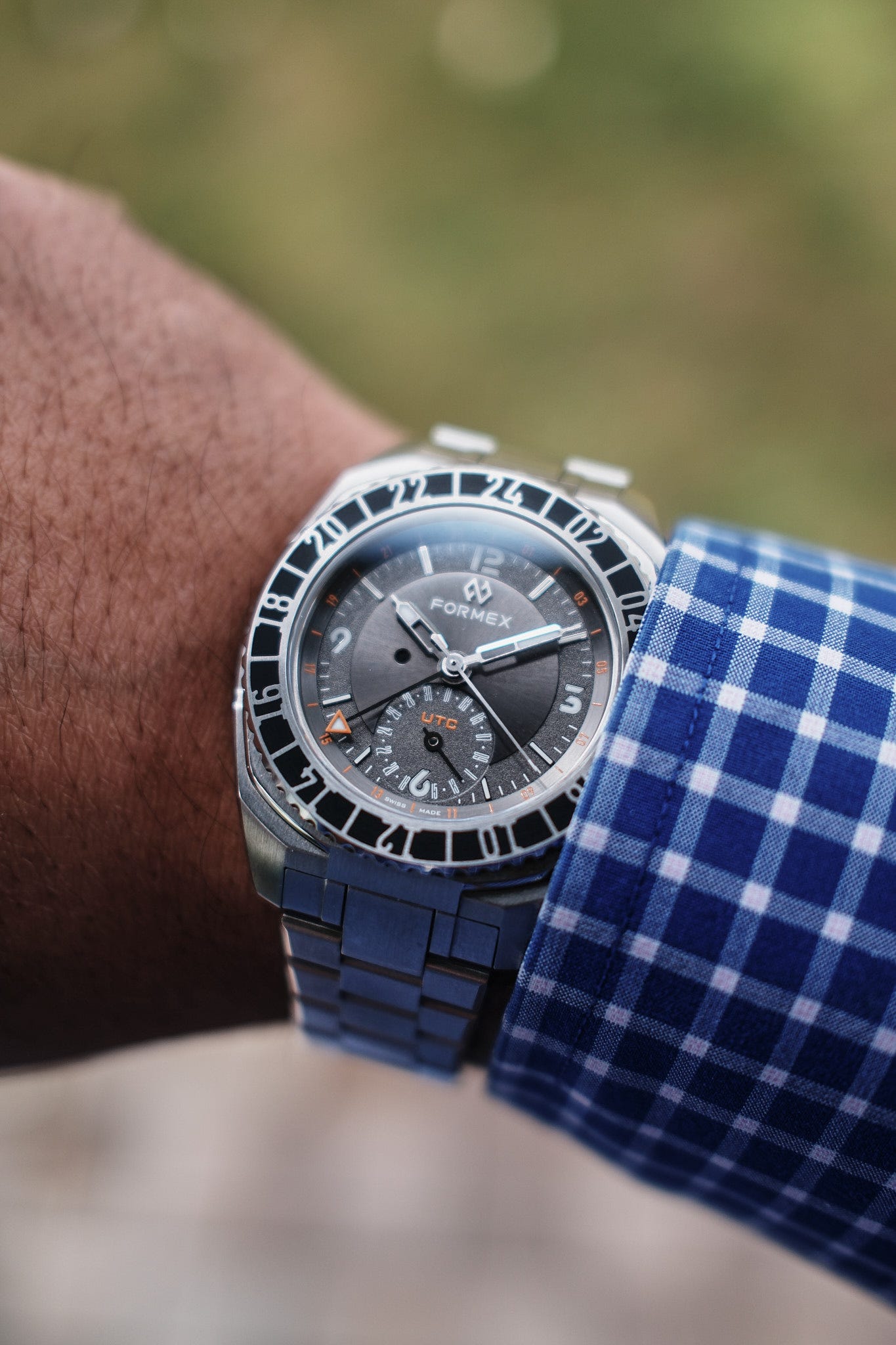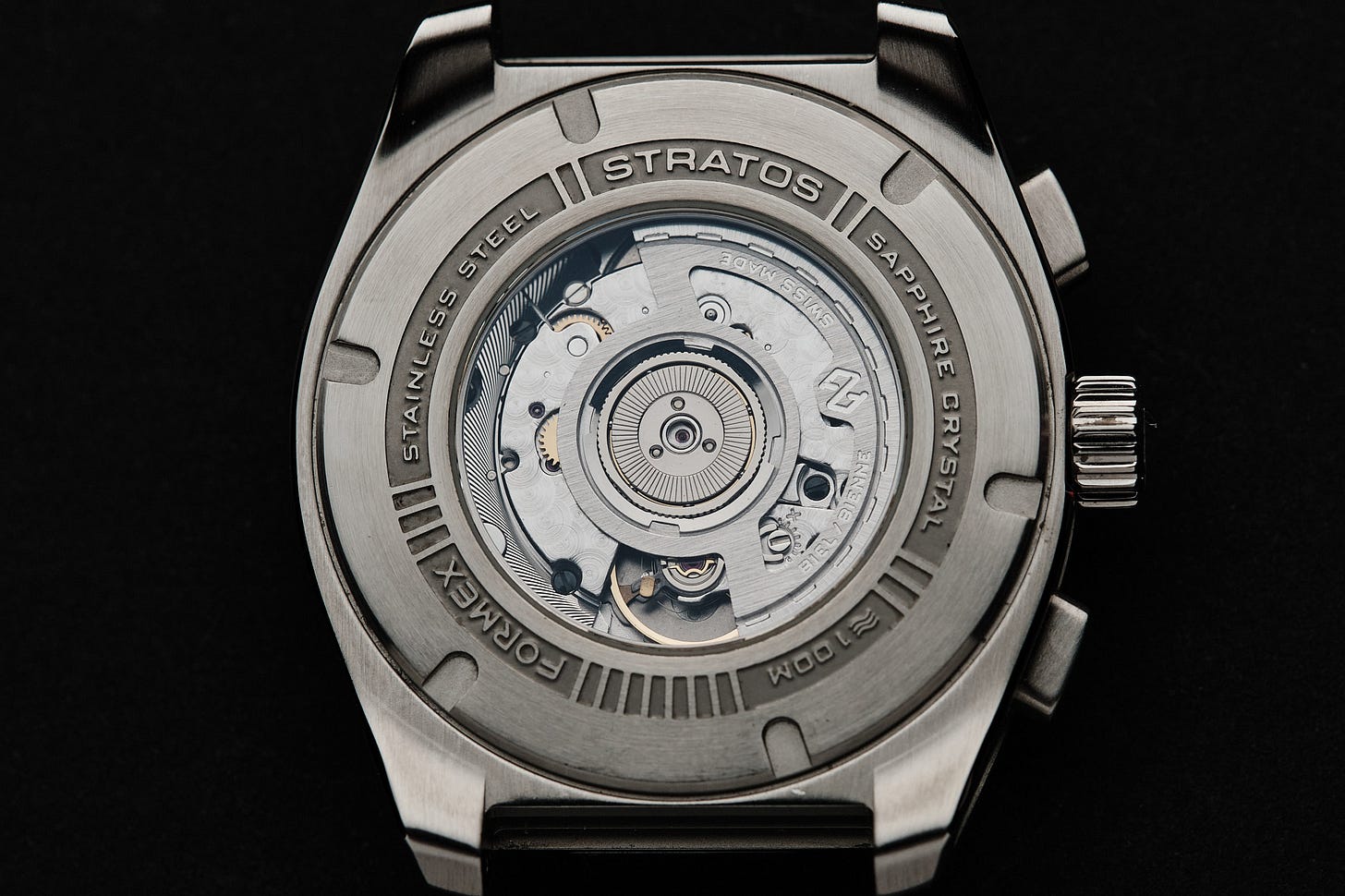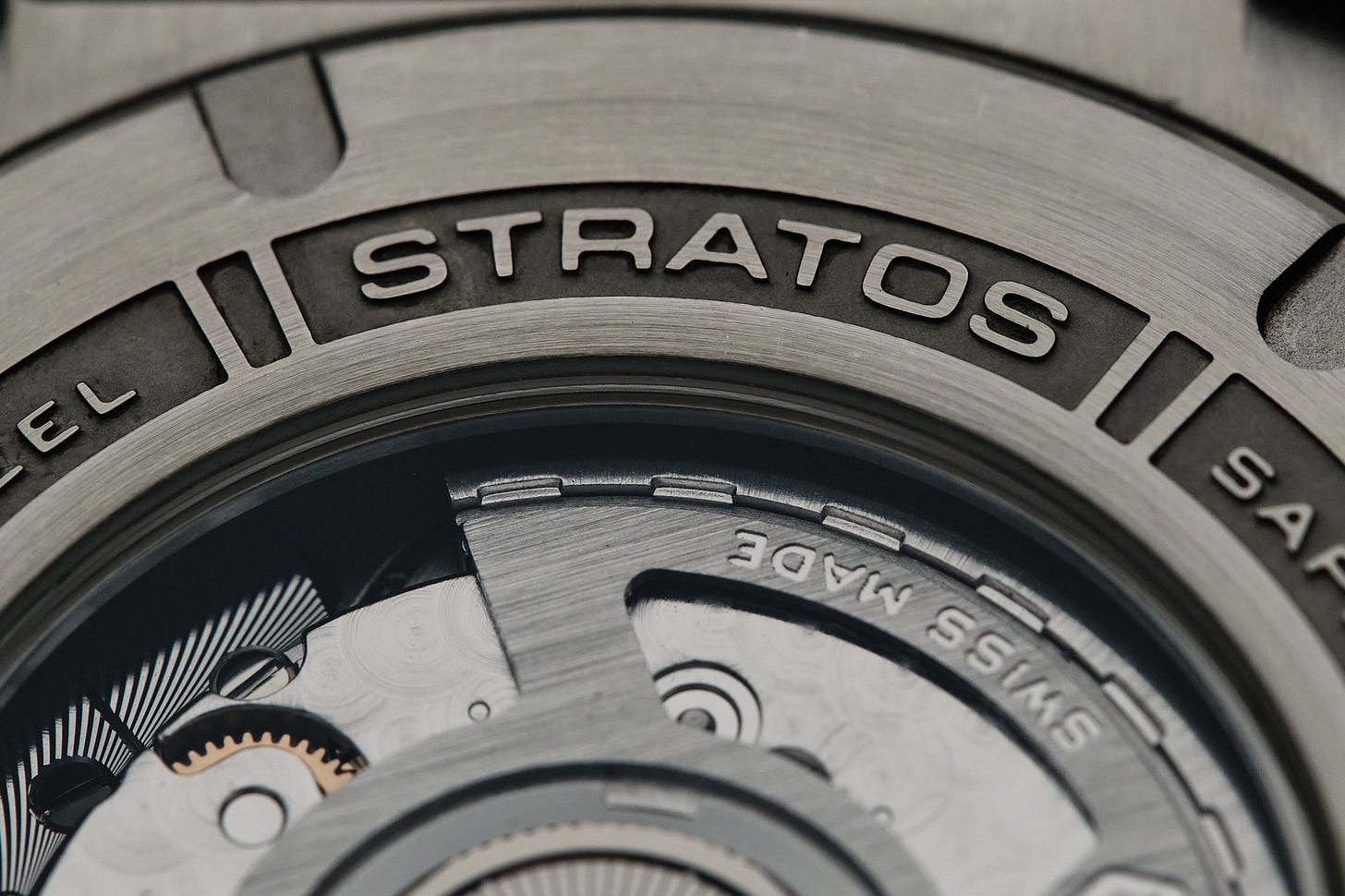Fast Impressions: The Formex Stratos UTC
The Stratos is basically Formex flexing its engineering muscle without breaking a sweat.
Formex is a brand that engineers its watches as much as it designs them. The new Stratos UTC is, in my opinion, the clearest example of this kind of duality. This is not a watch that echoes softness or subtlety. It is, in fact, unapologetically mechanical, visually assertive, and functionally deliberate. Everything about it feels intentional, from the angular case geometry to the way each surface finish seems to have been chosen to emphasize utility first and polish second. Yet somehow it feels every bit at home under a dress-shirt sleeve as it does under more rugged outerwear. This duality is perhaps the most fascinating thing about this watch, followed closely by the engineering and functionality that Formex has put into it.
A case built like equipment.
The Stratos case is 41 mm across and just 11.8 mm thick, landing in a sweet spot right between robust and wearable. The design borrows cues from their existing portfolio: the suspended case system, the sharply defined facet, the oversized deeply fluted crown. Yet somehow it feels condensed and tightly integrated. Every visible surface shows a very considered approach. Brush finishing dominates, while sandblasting fills recessed areas on the sides of the case. The only places on the case that show any polish are the chamfered edges.
The end result is a sort of modern brutalism: a mix of layered metalwork that communicates strength without bulk.
That attention to detail extends to the functional components as well. Two pushers on the right side at first suggest that this is a chronograph, but they actually control the jumping local hour hand. On the opposite flank is a discreet corrector that can be actuated with a pen or a pin and is used to advance the date pointer located in the small sub-dial at six o’clock. This is a compact and clever setup. It keeps the dial balanced while preserving a tactile mechanical interaction you will find hard not to fidget with.
More Than a GMT
Formex calls this watch a UTC rather than a GMT. That distinction is actually meaningful here. Most Swiss independent watchmakers rely on Sellita’s office GMT calibers, where the 24-hour hand is quick-set while the main hour hand remains static.
The Stratos UTC flips that. The local hour hand is set via the side pushers. This allows travelers to adjust to new time zones on the fly without changing the 24-hour reference hand.
I want to take a moment here and talk about this setup. As I mentioned earlier, most Swiss independents and micro brands that want to do GMTs are somewhat limited to the Sellita-made calibers. Right now, Sellita only makes office GMTs that are available at the price points that most of these makers want and need. Japanese movement maker Miyota recently released a true traveler GMT movement that has allowed indies and micros to start selling traveler GMTs for under a thousand dollars. But, to my knowledge, there isn’t yet a Swiss movement maker that is doing this.
Here’s where things get interesting with the Stratos. It doesn’t use a Sellita movement. It doesn’t even actually use a known GMT movement. Rather, it is based on the high-frequency ETA 2892 movement, which is an automatic self-winding caliber. What Formex has done is taken the ETA 2892 and fitted it with a custom module designed specifically for this functionality, made by Dubois-Dépraz.
I want to reflect on that for just a moment. Formex is a Swiss maker, located in the heart of Swiss watchmaking country, above the very workshop that manufactures their cases and other parts. I own a couple of their pieces myself, including an office/caller GMT. But they don’t make a watch with a traveller GMT.
At present, there are no traveler GMT movements made in Switzerland that are available to independent and micro-brand watchmakers (to my knowledge, anyway). So, if a Swiss brand wants to make a traveler GMT, they have to do so in a very unorthodox way. That is exactly what Formex did. By fitting a custom module on top of a well-known standard ETA movement, they have managed to pull off what I do not recall a single microbrand being able to do in recent memory.
If you’re not picking up what I’m putting down, I’m saying that this bit of movement engineering just proved that Formex has the chops to do something more than just design well. And, while this doesn’t come cheap at just under $4500, I look forward to seeing what else they come up with.
Layers of Function and Texture
The excellent mechanical engineering doesn’t mean that Formex has left their design DNA and ethos behind. The dial, in fact, carries that attention to detail forward. It’s almost architectural, a stepped composition with concentric textures that shift under the light. The outer 24-hour bezel ring is heavily brushed, as is the rehaut. That is followed by the main dial, which is textured in a way that resembles finely-milled tarmac. On top of that, a sunburst metallic center is intersected by a small circular sub-dial for the date. That sub-dial forms a subtle Venn-diagram overlap with the main dial. I think this is a really cool example of Formex’s ability to play with dimensionality rather than relying just on color contrast, as the sub-dial has that same texture resembling finely milled tarmac.
A day/night indicator on the dial alternates between black and orange, indicating whether the time on the dial is a.m. or p.m. It’s another thoughtful and clever touch that you could argue is not really necessary, but to me indicates just a level of thoughtfulness you don’t always get to see.
A Complete Package
The Stratos UTC is available on Formex’s stainless steel bracelet or on a leather strap. Both are equipped with the company’s excellent tool-free micro-adjust systems. The bracelet’s clasp allows fine incremental sizing, while the strap features their ingenious sliding extension that’s built right into the deployant. I really appreciate that the case has a 20 mm lug width rather than 22, which they could have gone with given the size of this watch.
All told, the Stratos feels like Formex truly flexing its engineering skills. I will fully admit that the case design is not necessarily going to be a hit with everyone (although it certainly is with me). Paired with the layered finishing and this distinct design language, the result is a watch that genuinely earns the designation of “tool watch”. It is purposeful, tactile, and refined in execution.









